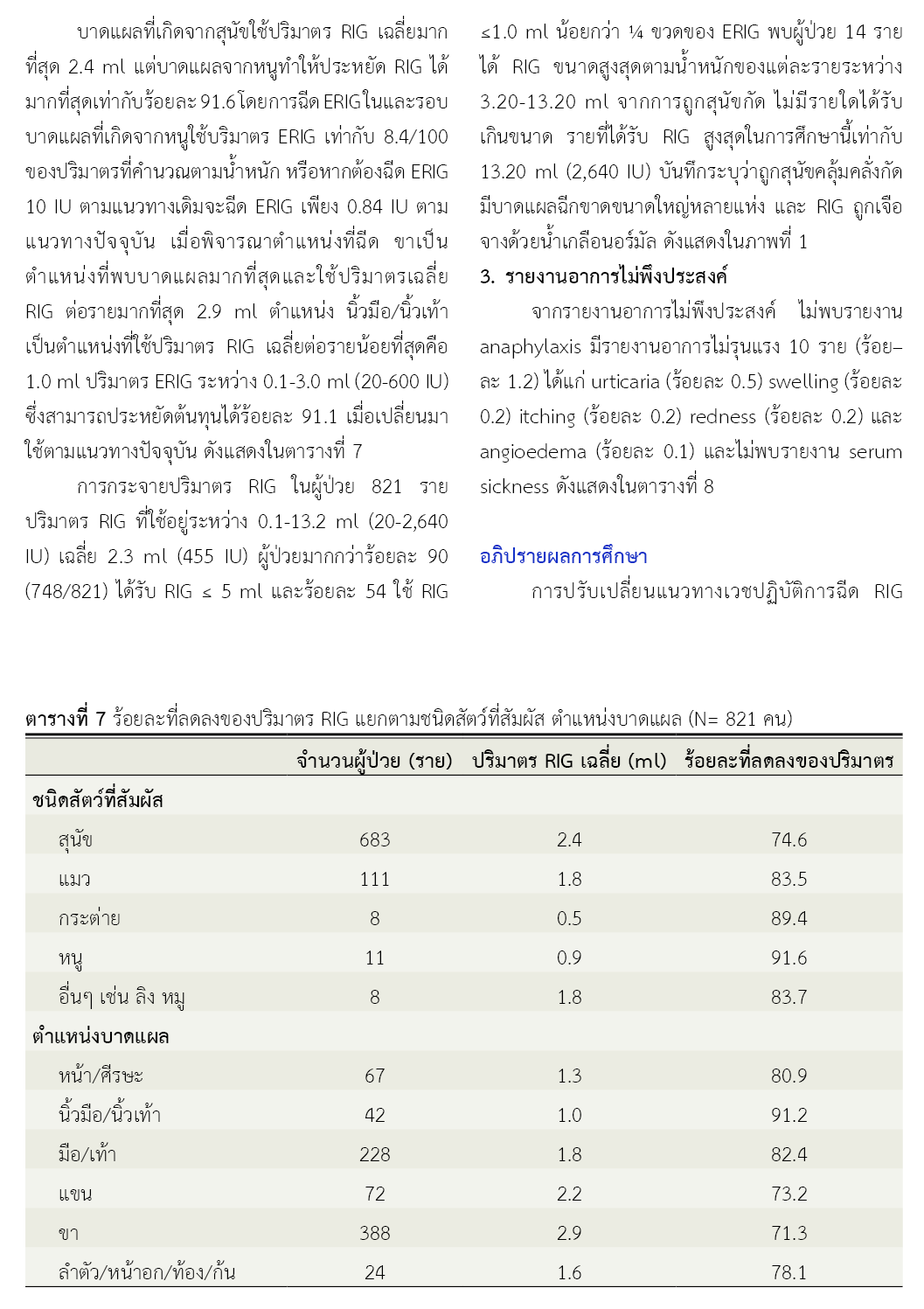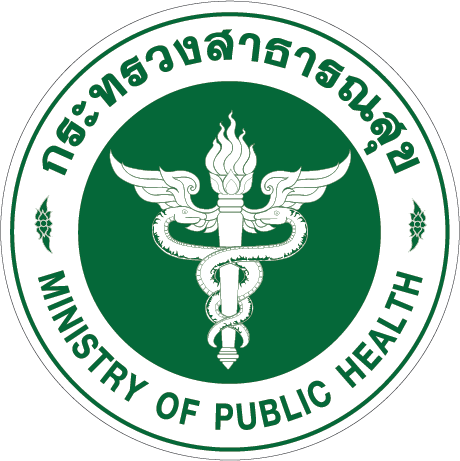Cost savings from revised guideline of rabies immunoglobulin administration
Keywords:
rabies, immunoglobulin, RIG, guideline, costAbstract
Background: Before 2018, the guideline of rabies immunoglobulin (RIG) administration was recommended to infiltrate RIG as much as possible into and around the wound if anatomically feasible. Any remaining volume was injected intramuscularly. In 2018 the World Health Organization (WHO) and the Ministry of Public Health of Thailand (Thai MOPH) revised the guideline by infiltrating of RIG into and around the wound only up to the maximum calculated volume, does not required to be injected intramuscularly. In the previous guideline, the dose and volume of rabies immunoglobulin was based on body weight while the current guideline based on size and numbers of the bite wounds.
Objective: To compare the cost of RIG vaccination between the previous and the current guideline according to volume and cost of RIG.
Method: Retrospective study on patients who were rabies exposures and received RIG at out-patients department (OPD) during fiscal year 2020.
Results: A total of 821 cases were included in the study. When comparing between the previous and the current guideline, it was found that the volume of RIG was used 8,321.5 ml and 1,873.1 ml, respectively. The average volume of RIG per case decreased from 10.1 ml to 2.3 ml (77.5%). The total cost of RIG was 998,268.8 baht according to the previous guideline while only 236,252.4 baht for the current guideline. The average cost per case was decreased from 1,215.9 to 287.7 baht, which saved 76.3%. The average volume and cost of RIG according to the current guideline were decreased significantly when compare to the previous guideline (P <0.01). Ten cases (1.2%) were reported minor adverse events without anaphylaxis.
Conclusion: This study has shown that the current guideline of RIG administration reducing volume and cost of RIG obviously.
References
พักต์เพ็ญ สิริคุตต์. โรคพิษสุนัขบ้าในประเทศไทย [อินเทอร์เน็ต]. 2561 [เข้าถึงเมื่อ 10 ตุลาคม 2563]. เข้าถึงได้จาก: https://www.pidst.or.th/A659.html
ชาญเกียรติ์ เพียรชนะ. แนวทางการป้องกันและการดูแลรักษาผู้ที่สัมผัสโรคพิษสุนัขบ้า [อินเทอร์เน็ต]. 2563 [เข้าถึงเมื่อ 10 มกราคม 2564]. เข้าถึงได้จาก: https://ccpe.pharmacycouncil.org/index.php?option=article_detail&subpage=article_detail&id=929
สำนักระบาดวิทยา กรมควบคุมโรค กระทรวงสา–ธารณสุข. Rabies ข้อมูลย้อนหลัง สรุปสถานการณ์รายปี. [อินเทอร์เน็ต]. 2563 [เข้าถึงเมื่อ 5 มกราคม 2564]. เข้าถึงได้จาก: http://www.boe.moph.go.th/boedb/surdata/disease.php?dcontent=old&ds=42
กรมควบคุมโรค สำนักโรคติดต่อทั่วไป. แนวทางการดำเนินงานป้องกันควบคุมโรคพิษสุนัขบ้า [อินเทอร์เน็ต]. กรุงเทพฯ: สำนักโรคติดต่อทั่วไป กรมควบคุมโรค กระทรวงสาธารณสุข; 2560 [เข้าถึงเมื่อ 2 มกราคม 2564]. 266. เข้าถึงได้จาก: http://e-lib.ddc.moph.go.th/pdf/material_744/material_744.pdf
กรมควบคุมโรค สำนักโรคติดต่อทั่วไป. แนวทางเวชปฏิบัติโรคพิษสุนัขบ้าและคำถามที่พบบ่อย [อินเทอร์เน็ต]. กรุงเทพฯ: กลุ่มโรติดต่อระหว่างสัตว์และคน สำนักโรคติดต่อทั่วไป กรมควบคุมโรค กระทรวงสาธารณสุข; 2559 [เข้าถึงเมื่อ 14 กันยายน 2563]. 90. เข้าถึงได้จาก: http://r36.ddc.moph.go.th/r36/uploads/document/584adb73e3d0f.pdf
Bharti OK, Madhusudana SN, Gaunta PL, Belludi AY. Local infiltration of rabies immunoglobulins without systemic intramuscular administration: An alternative cost effective approach for passive immunization against rabies. Hum Vaccin Immunother 2016;12(3):837-42.
Bharti OK, Madhusudana SN, Wilde H. Injecting rabies immunoglobulin (RIG) into wounds only: A significant saving of lives and costly RIG. Hum Vaccin Immunother 2017;13(4):762-5.
Bharti OK, Thakur B, Rao R. Wound-only injection of rabies immunoglobulin (RIG) saves lives and costs less than a dollar per patient by “pooling strategy”. Vaccine 2019;37(Suppl 1):A128-31.
Ravish HS, Kumari N, Ramya MP, Surendran J. Safety of rabies immunoglobulin (RIG)/rabies monoclonal antibody (RMAb) for post-exposure prophylaxis in patients with potential rabies exposure. APCRI Journal [Internet]. 2019 [cited 2021 Jan 2];21(1):22-27. Available from: http://apcrijournal.com/MainPageArticles/VOL.%20XXI%20ISSUE%20I-Article_4.pdf
World Health Organization. Frequently asked questions about rabies for clinicians [Internet]. 2018 [cited 2020 Nov 2]. Available from: https://www.who.int/rabies/Rabies_Clinicians_FAQs_21Sep2018.pdf
Behera TR, Satapathy DM, Sahu T, Pratap AK. Safety of equine rabies immunoglobulin injection into fingers and toes. Asian Biomedicine [Internet]. 2012 [cited 2020 Oct 17];6(3):429-432. Available from: https://sciendo.com/pdf/10.5372/1905-7415.0603.139
World Health Organization. WHO expert consultation on rabies, third report [Internet]. Geneva: World Health Organization; 2018 [cited 2020 Oct 10]. Available from: https://apps.who.int/iris/bitstream/handle/10665/272364/9789241210218-eng.pdf?sequence =1&isAllowed=y
Hwang GS, Rizk E, Bui LN, Iso T, Sartain EI, Tran AT, Swan JT. Adherence to guideline recommendations for human rabies immune globulin patient selection, dosing, timing, and anatomical site of administration in rabies postexposure prophylaxis. Hum Vaccin Immunother. 2020;16(1):51-60. doi: 10.1080/21645515.2019.1632680.
กระทรวงสาธารณสุข กรมควบคุมโรค สำนักโรคติดต่อทั่วไป. การปรับปรุงแนวทางเวชปฏิบัติการฉีดวัคซีนป้องกันโรคพิษสุนัขบ้า. [อินเทอร์เน็ต]. 2561 [เข้าถึงเมื่อ 20 กันยายน 2563]. เข้าถึงได้จาก: http://r36.ddc.moph.go.th/r36/content/view/6/129/
Schreuder I, Pijper CD, Kessel RV, Visser L, Kerkhof HVD. Abandon of intramuscular administration of rabies immunoglobulin for post-exposure prophylaxis in the revised guidelines in the Netherlands in 2018: cost and volume savings. Euro Surveill 2020;25(38):1-5.
Agarwal A, Kumar P, Mathur SB, Khan AM. Estimating the volume of equine rabies immunoglobulin (eRIG) required for local infiltration in soft tissue animal bites in children using a wound size-based approach. J Trop Pediatr [Internet]. 2021 [cited 2021 Oct 10];67(4). Doi: 10.1093/tropej/fmab082.

Downloads
Published
How to Cite
Issue
Section
License
Copyright (c) 2021 Health Administration Division, Office of the Permanent Secretary, Ministry of Public Health and The Society of Hospital Pharmacist, Ministry of Public Health

This work is licensed under a Creative Commons Attribution-NonCommercial-NoDerivatives 4.0 International License.
ข้อความภายในบทความที่ตีพิมพ์ในวารสารเภสัชกรรมคลินิกทั้งหมด รวมถึงรูปภาพประกอบ ตาราง เป็นลิขสิทธิ์ของกองบริหารการสาธารณสุข สำนักงานปลัดกระทรวงสาธารณสุข และ ชมรมเภสัชกรโรงพยาบาลกระทรวงสาธารณสุข การนำเนื้อหา ข้อความหรือข้อคิดเห็น รูปภาพ ตาราง ของบทความไปจัดพิมพ์เผยแพร่ในรูปแบบต่าง ๆ เพื่อใช้ประโยชน์ในเชิงพาณิชย์ ต้องได้รับอนุญาตจากกองบรรณาธิการวารสารเภสัชกรรมคลินิกอย่างเป็นลายลักษณ์อักษร
กองบริหารการสาธารณสุข สำนักงานปลัดกระทรวงสาธารณสุข และ ชมรมเภสัชกรโรงพยาบาลกระทรวงสาธารณสุข อนุญาตให้สามารถนำไฟล์บทความไปใช้ประโยชน์และเผยแพร่ต่อได้ โดยอยู่ภายใต้เงื่อนไขสัญญาอนุญาตครีเอทีฟคอมมอน (Creative Commons License: CC) โดย ต้องแสดงที่มาจากวารสาร – ไม่ใช้เพื่อการค้า – ห้ามแก้ไขดัดแปลง, Attribution-NonCommercial-NoDerivatives 4.0 International (CC BY-NC-ND 4.0)
ข้อความที่ปรากฏในบทความในวารสารเป็นความคิดเห็นส่วนตัวของผู้เขียนแต่ละท่านไม่เกี่ยวข้องกับกองบริหารการสาธารณสุข สำนักงานปลัดกระทรวงสาธารณสุข และ ชมรมเภสัชกรโรงพยาบาลกระทรวงสาธารณสุข และบุคลากรในกองฯ หรือ ชมรมฯ แต่อย่างใด ความรับผิดชอบองค์ประกอบทั้งหมดของบทความแต่ละเรื่องเป็นของผู้เขียนแต่ละท่าน หากมีความผิดพลาดใด ๆ ผู้เขียนแต่ละท่านจะรับผิดชอบบทความของตนเอง ตลอดจนความรับผิดชอบด้านเนื้อหาและการตรวจร่างบทความเป็นของผู้เขียน ไม่เกี่ยวข้องกับกองบรรณาธิการ



